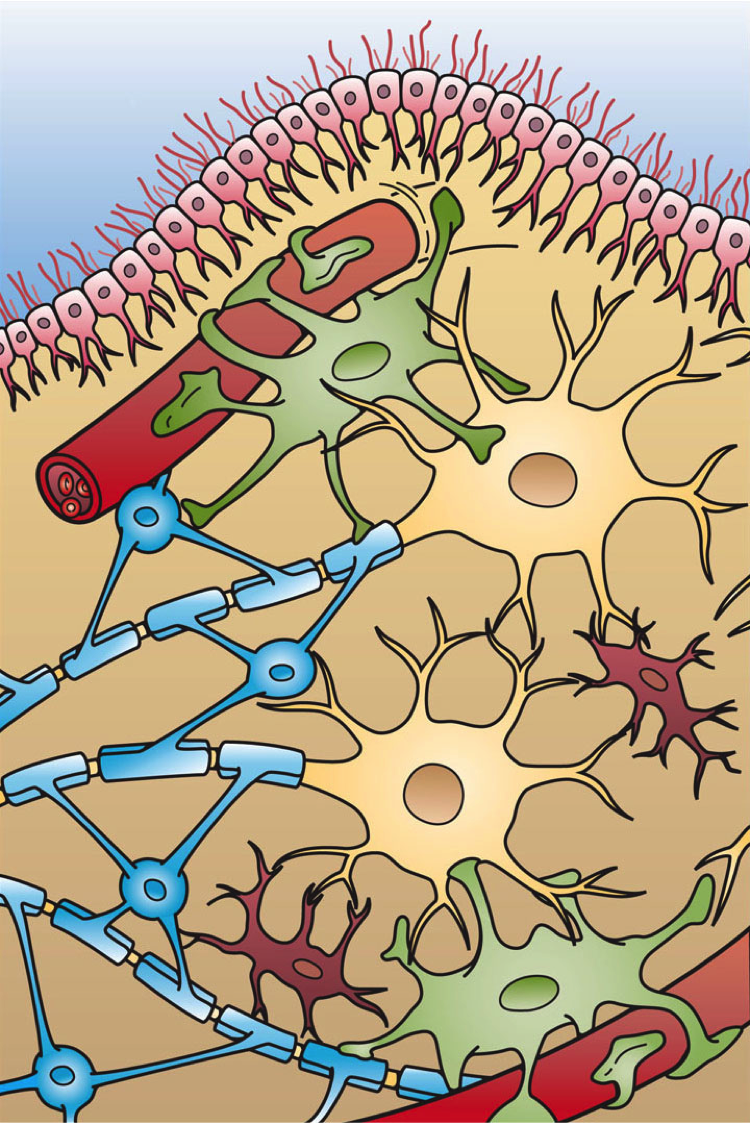|
Oligoclonal Band
Oligoclonal bands (OCBs) are bands of immunoglobulins that are seen when a patient's blood serum, or cerebrospinal fluid (CSF) is analyzed. They are used in the diagnosis of various neurological and blood diseases, especially in multiple sclerosis. Two methods of analysis are possible: (a) protein electrophoresis, a method of analyzing the composition of fluids, also known as "SDS-PAGE (sodium dodecyl sulphate polyacrylamide gel electrophoresis)/Coomassie blue staining", and (b) the combination of isoelectric focusing/silver staining. The latter is more sensitive. For the analysis of cerebrospinal fluid, a sample is first collected via lumbar puncture (LP). Normally it is assumed that all the proteins that appear in the CSF, but are not present in the serum, are produced intrathecally (inside the central nervous system). Therefore, it is normal to subtract bands in serum from bands in CSF when investigating CNS diseases. A sample of blood serum is usually obtained from a clotted bl ... [...More Info...] [...Related Items...] OR: [Wikipedia] [Google] [Baidu] |
Epstein–Barr Virus
The Epstein–Barr virus (EBV), formally called ''Human gammaherpesvirus 4'', is one of the nine known human herpesvirus types in the herpes family, and is one of the most common viruses in humans. EBV is a double-stranded DNA virus. It is best known as the cause of infectious mononucleosis ("mono" or "glandular fever"). It is also associated with various non-malignant, premalignant, and malignant Epstein–Barr virus-associated lymphoproliferative diseases such as Burkitt lymphoma, hemophagocytic lymphohistiocytosis, and Hodgkin's lymphoma; non-lymphoid malignancies such as gastric cancer and nasopharyngeal carcinoma; and conditions associated with human immunodeficiency virus such as hairy leukoplakia and central nervous system lymphomas. The virus is also associated with the childhood disorders of Alice in Wonderland syndrome and acute cerebellar ataxia and, by some evidence, higher risks of developing certain autoimmune diseases, especially dermatomyositis, systemic lu ... [...More Info...] [...Related Items...] OR: [Wikipedia] [Google] [Baidu] |
Neurosarcoidosis
Neurosarcoidosis (sometimes shortened to neurosarcoid) refers to a type of sarcoidosis, a condition of unknown cause featuring granulomas in various tissues, in this type involving the central nervous system (brain and spinal cord). Neurosarcoidosis can have many manifestations, but abnormalities of the cranial nerves (a group of twelve nerves supplying the head and neck area) are the most common. It may develop acutely, subacutely, and chronically. Approximately 5–10 percent of people with sarcoidosis of other organs (e.g. lung) develop central nervous system involvement. Only 1 percent of people with sarcoidosis will have neurosarcoidosis alone without involvement of any other organs. Diagnosis can be difficult, with no test apart from biopsy achieving a high accuracy rate. Treatment is with immunosuppression. The first case of sarcoidosis involving the nervous system was reported in 1905. Signs and symptoms Neurological Abnormalities of the cranial nerves are present in 50–7 ... [...More Info...] [...Related Items...] OR: [Wikipedia] [Google] [Baidu] |
Systemic Lupus Erythematosus
Lupus, technically known as systemic lupus erythematosus (SLE), is an autoimmune disease in which the body's immune system mistakenly attacks healthy tissue in many parts of the body. Symptoms vary among people and may be mild to severe. Common symptoms include painful and swollen joints, fever, chest pain, hair loss, mouth ulcers, swollen lymph nodes, feeling tired, and a red rash which is most commonly on the face. Often there are periods of illness, called flares, and periods of remission during which there are few symptoms. The cause of SLE is not clear. It is thought to involve a mixture of genetics combined with environmental factors. Among identical twins, if one is affected there is a 24% chance the other one will also develop the disease. Female sex hormones, sunlight, smoking, vitamin D deficiency, and certain infections are also believed to increase a person's risk. The mechanism involves an immune response by autoantibodies against a person's own tissues. T ... [...More Info...] [...Related Items...] OR: [Wikipedia] [Google] [Baidu] |
Neuromyelitis Optica
Neuromyelitis optica spectrum disorders (NMOSD), including neuromyelitis optica (NMO), are autoimmune diseases characterized by acute inflammation of the optic nerve (optic neuritis, ON) and the spinal cord (myelitis). Episodes of ON and myelitis can be simultaneous or successive. A relapsing disease course is common, especially in untreated patients. In more than 80% of cases, NMO is caused by immunoglobulin G Autoantibody, autoantibodies to aquaporin 4 (anti-AQP4 diseases, anti-AQP4), the most abundant Aquaporin, water channel protein in the central nervous system. A subset of anti-AQP4-negative cases is associated with antibodies against myelin oligodendrocyte glycoprotein (Anti-MOG associated encephalomyelitis, anti-MOG). Rarely, NMO may occur in the context of other autoimmune diseases (e.g. Connective tissue disease, connective tissue disorders, paraneoplastic syndromes) or infectious diseases. In some cases, the etiology remains unknown (Idiopathic disease, idiopathic NMO). ... [...More Info...] [...Related Items...] OR: [Wikipedia] [Google] [Baidu] |
Lyme Disease
Lyme disease, also known as Lyme borreliosis, is a vector-borne disease caused by the ''Borrelia'' bacterium, which is spread by ticks in the genus ''Ixodes''. The most common sign of infection is an expanding red rash, known as erythema migrans (EM), which appears at the site of the tick bite about a week afterwards. The rash is typically neither itchy nor painful. Approximately 70–80% of infected people develop a rash. Early diagnosis can be difficult. Other early symptoms may include fever, headaches and tiredness. If untreated, symptoms may include loss of the ability to move one or both sides of the face, joint pains, severe headaches with neck stiffness or heart palpitations. Months to years later repeated episodes of joint pain and swelling may occur. Occasionally shooting pains or tingling in the arms and legs may develop. Despite appropriate treatment about 10 to 20% of those affected develop joint pains, memory problems and tiredness for at least six months. Lym ... [...More Info...] [...Related Items...] OR: [Wikipedia] [Google] [Baidu] |



